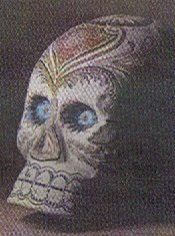The head
of
Hotu A
Matua.was cut off (Gb1-10) at the end of his
term, when
τ Aquilae was at the Sun.
In the preceding Gb1-9
the severed head is down at left and the design
could have been drawn to indicate where it was buried (at Te Avaava
Maea).
|
Maea
Stone, rock. Vanaga.
Stone, rock; maea
kore, free of stones; maea
horohoro, snowy rock; maea
mataa, obsidian used for spear heads
T; maea matariki, stone used for
the images T; maea pupura, hard
cellular stones used in the platforms T;
maea puruhare, tile; maea
regorego, a flinty beach pebble used
for the finest stone implements T;
maea toki, hard slates, black, red
and gray, used for axes T; maea
viriviri, grindstone. Churchill. |
 |
 |
 |
 |
 |
|
Gb1-9 |
Gb1-10 |
Gb1-11 (240) |
Gb1-12 |
Gb1-13 |
|
NOVEMBER 14 |
15 |
16 (320) |
17 |
18 |
|
ε Pavonis, θ Sagittarii (302.3), γ Sagittae
(302.5), μ Pavonis (302.7) |
τ Aquilae
(303.8) |
20h (304.4) |
Shang Wei (305.2), θ Sagittae (305.4),
Tseen Foo (305.6), ξ Capricorni (305.8) |
Tso Ke (306.3) |
|
η Sagittae (304.2), δ Pavonis (304.4) |
|
January 17 |
18 (383) |
19 |
20 |
21 |
|
NAKSHATRA DATES: |
|
MAY 16 |
17 (137) |
18 |
19 |
20 |
|
ω Cancri (120.2) |
8h (121.7) |
ρ Puppis
(122.0), Heap of Fuel (122.1), ζ Monocerotis
(122.3), ψ Cancri (122.6), Regor (122.7) |
Tegmine (123.3) |
Al Tarf (124.3)
Ras
Algethi |
|
χ Gemini
(121.0),
Naos (121.3) |
|
July 19 (200) |
20 |
21 |
22 |
23 |
The word avaava is more
difficult, but the type of arm in Gb1-12 is
kava, possibly also that in Gb1-11. And
areheu is my provisional title for another
type of glyph which was used here.
|
Are To
dig out (e.g. sweet potatoes).
Formerly this term only applied to
women, speaking of men one said
keri, which term is used
nowadays for both sexes, e.g.
he-keri i te kumara, he digs out
sweet potatoes. Vanaga.
To dig, to
excavate. Churchill. |
... It ran and slipped into the hole of
a stone. He poked after it, lifted up
the stone, and saw that the skull was
(in the hole) of the stone. (The rat
was) a spirit of the skull (he kuhane
o te puoko).
Ure Honu
was amazed and said, 'How beautiful you
are! In the head of the new bananas is a
skull, painted with yellow root and with
a strip of barkcloth around it.'

 |
 |
 |
 |
 |
 |
|
Gb1-14 |
Gb1-15 |
Gb1-16 |
Gb1-17 |
Gb1-18 |
Gb1-19 (248) |
|
NOVEMBER 19 |
20 (324) |
21 |
22 |
23 |
24 |
|
Gredi
(307.2), σ Capricorni (307.5), Alshat
(307.9) |
Al Sa’d al Dhabih-20 /
Ox / Herd Boy-9 |
Okul (309.6), Bos (309.9)
Arneb
|
ο Capricorni (310.2), θ Cephei (310.5)
Alnilam
|
Rotten Melon, φ Pavonis (311.2), η
Delphini (311.4), ζ Delphini, ρ Pavonis
(311.7)
Phakt
|
Rotanev,
ι Delphini (312.3), τ Capricorni (312.6), κ
Delphini (312.7),
SVALOCIN,
υ Capricorni, υ Pavonis (312.8) |
|
DABIH
(308.0), κ Sagittarii (308.1), Sadir
(308.4), Peacock (308.7) |
|
January 22 |
23 |
24 |
25 |
26 |
27 (392) |
|
NAKSHATRA DATES: |
|
MAY 21 |
22 |
23 |
24 |
25 |
26 (146) |
|
χ Cancri
(125.2), Bright Fire (125.4) |
Avior (126.4), φ
Cancri (126.8) |
ο Ursa Majoris
(127.4) |
Pushya-8 |
Āshleshā-9 /
Willow-24 |
Al Nathrah-6 |
|
υ Cancri
(128.1),
θ CANCRI (128.2),
η Cancri (128.5) |
π¹ Ursa Majoris,
δ HYDRAE (129.6),
Al Minhar al Shujā,
Museida
(129.9)
Ras
Alhague
|
BEEHIVE
(130.4),
Xestus (130.5),
Ascellus Borealis
(130.9) |
|
July 24 |
25 |
26 |
27 |
28 |
29 (210) |
Gb1-18 could allude to January 18
(1-18), which was 8 days earlier. Gb1-19 is an example of areheu and
what is uplifted by the preceding fish-hook could
possibly be the
head which had been buried, or its soul.
... When all had left, when all the brothers
were asleep, Tuu Maheke came and cut
off the head of Hotu A
Matua. Then he covered everything
with soil. He hid (the head), took it, and
went up. When he was inland, he put (the
head) down at Te Avaava Maea. Another
day dawned, and the men saw a dense swarm of
flies pour forth and spread out like a
whirlwind (ure tiatia moana) until it
disappeared into the sky.
Tuu Maheke
understood. He went up and took the head,
which was already stinking in the hole in
which it had been hidden. He took it and
washed it with fresh water. When it was
clean, he took it and hid it anew.
Another day came, and again Tuu Maheke
came and saw that it was completely dried
out (pakapaka). He took it, went
away, and washed it with fresh water until
(the head) was completely clean. Then he
took it and painted it yellow (he pua hai
pua renga) and wound a strip of
barkcloth (nua) around it.
He took it and hid it in the hole of a stone
that was exactly the size of the head. He
put it there, closed up the stone (from the
outside), and left it there. There it stayed
...
|






